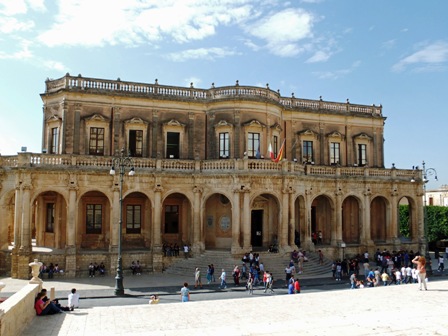
Noto Municipal Building
Click the photo above to see an album for this episode. Close the window to return to this page.
 Noto Municipal Building Click the photo above to see an album for this episode. Close the window to return to this page. |
|
Siracusa Sicily It is boring always taking the fastest route, so we look for the scenic routes, marked with a green side stripe on our map. As long as the hairpin turns indicated don’t look too frequent and it is a yellow road, not a grey road, we will give it a try. The only problem is our map only gives the route numbers of the red and black routes. This means we sometimes surprise ourselves when we discover we actually are on the route we aimed for, but that is the fun of the game. That was the case when we drove out of Ragusa, hoping to see the countryside from the scenic route to Modica. The GPS kept trying to turn us around and head for the faster red road, but I had turned off the annoying voice that kept admonishing us. The route was great, downhill with little traffic and wonderful views of the countryside. We didn’t stop in Modica. Our detour destination for the day was Noto, another town turned into a Baroque gem after the devastating earthquake of 1693. Actually the town, originally built by the Romans, was so badly damaged that it was left where it was and the new town was built 8 km to the south. The ruins of Noto Antica are still there for visitors who are interested in archaeological sites. We were not that day. I don’t know why but demonstrations seem to follow us. The day we visited Noto, a medium sized crowd of students marched to the Municipal building carrying large, home-made banners and waving flags. I couldn’t translate the slogans so I have no idea what the cause of the day was, but it was a peaceful march watched over by a few police. Actually I spied several students give up the march very early because the best Gelato shop in town was right there. Noto is supposed to have the best gelato in Sicily, so of course we had to see if it met our standards too. It was pretty good. I think more comparisons will have to be made in other towns. Right across from the Municipal building is the Duomo. Scaffolding, put up to paint the ceiling and upper walls, took up the entire center part of the church, part of an ongoing restoration after the entire roof and center dome collapsed in 1996 after being weakened by an earthquake in 1990. Photos in the church showed nothing but a pile of rubble in the center of the church. The interior had to be replaced, a new roof put on and frescoes and windows renewed. It is an ongoing project. We walked through the small town taking photos of the many baroque palaces of the wealthy families in the 17th C. The Church of Montevergine (San Girolamo) was reached by sets of stairs leading from the main street up the steep hill. You get a good view of the town from roof of the church but what interested me was the display of the costumes of the various fraternal organizations, and two women’s organizations, all associated with the Catholic church. Most had their beginnings as far back as the 15thC. All had a cape of various colours and a front piece displaying their heraldic crest. The groups still march behind their banners on various Saints days, proudly carrying the relic belonging to their church. We bought food in Noto for a picnic on the road, hopefully within sight of the famous canyon, the Cava Grande di Cassabile. We easily found the yellow road that twisted and turned farther into the mountains but had to settle for an obscured view as we ate our food standing beside the car. Sicily doesn’t have any of those convenient picnic benches that we like to use for a lunch on the road. The rest of the way to Siracusa was easy and we were soon parked beside our B&B L’Infiorescenza, next door to an associated cafe with tables on the sidewalk facing the Piazza Santa Lucia. We had come to visit Ortigia, a medieval and Baroque town on an island joined to mainland Siracusa by several bridges, but we were staying on the mainland, partially because our guide book indicated parking might be a problem in Ortigia.
Christian burials during Roman occupation of Siracusa were forbidden. The solution was to place the graves underground, using tunnels created by the Greeks for aqueducts. It was considered prestigious to be buried as close to Santa Lucia as possible resulting in a huge system of catacombs underneath the church and the entire large Piazza. All the bodies were removed from their graves and buried elsewhere in 1940 to make room for citizens of Siracusa who sheltered underground during frequent bombings during WWII. Just part of the catacombs is available to visit, but it still was quite extensive, but no photos were permitted. One of the downsides of staying in mainland Siracusa is the lack of restaurants. It has started to rain lightly in the evening. We walked under our umbrellas to find a good place to have a meal. There were a few gelaterias, pizzareas and snack bars in our section of town, but no full service restaurants. We settled for pizza place with tables to share a good pizza and pasta, and overpriced and forgettable wine. For the rest of our stay in Siracusa we will be eating our main meal at lunch and having a snack for dinner.
|
||
Read Rome Sept-Oct 2013
Return to Sicily Intro
Return to Italy Intro
Return to Travels
Return to Introduction